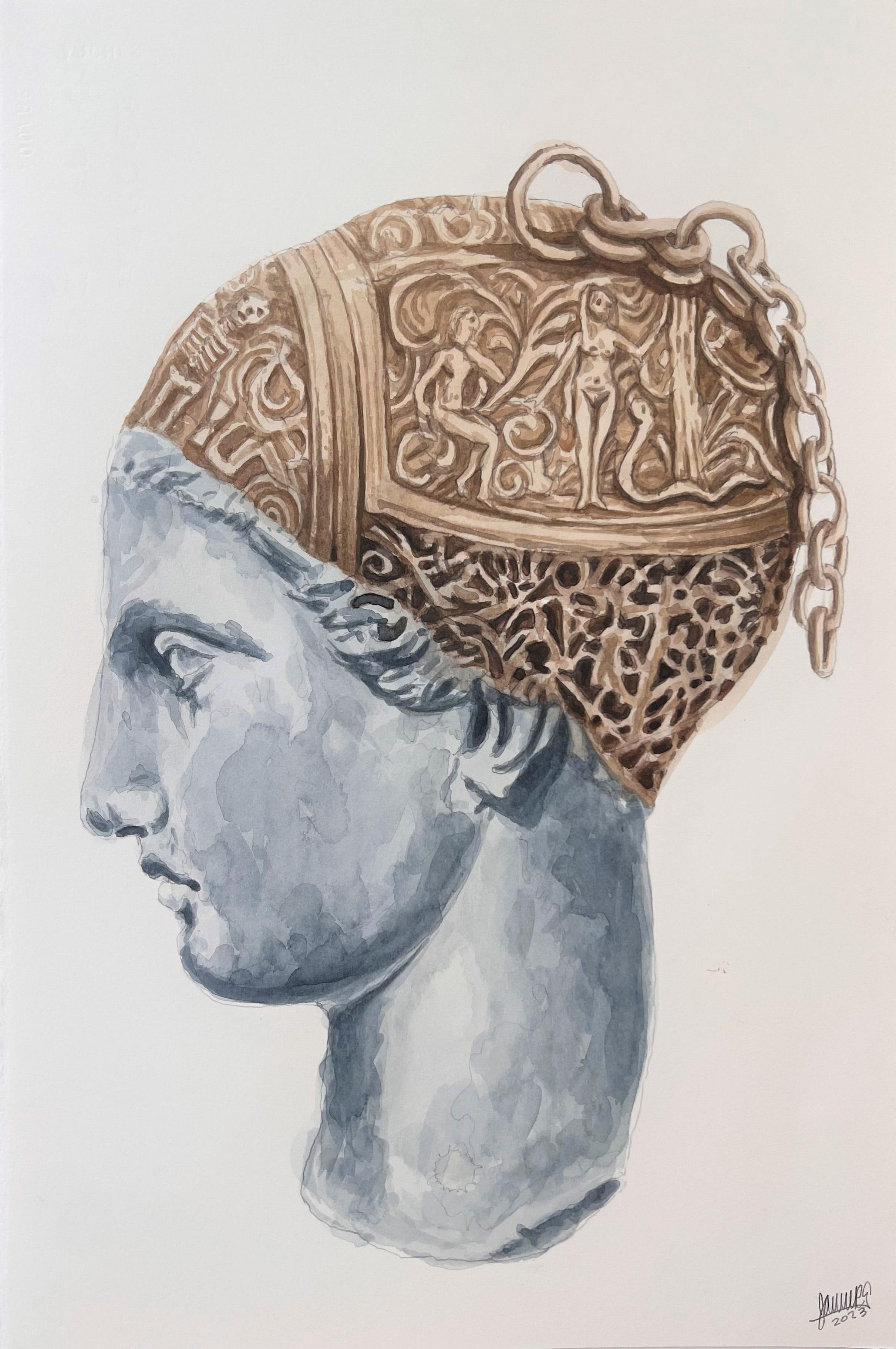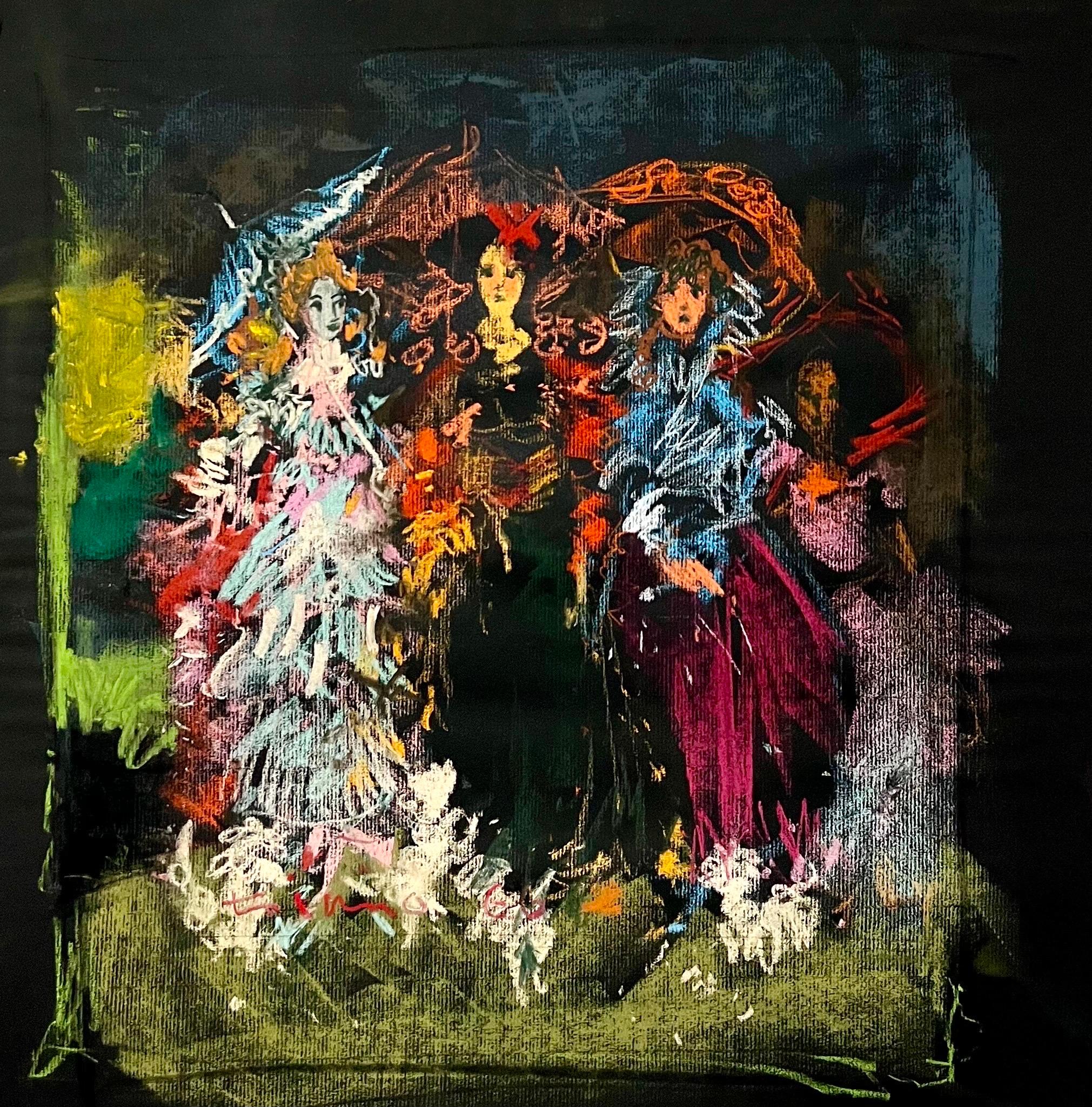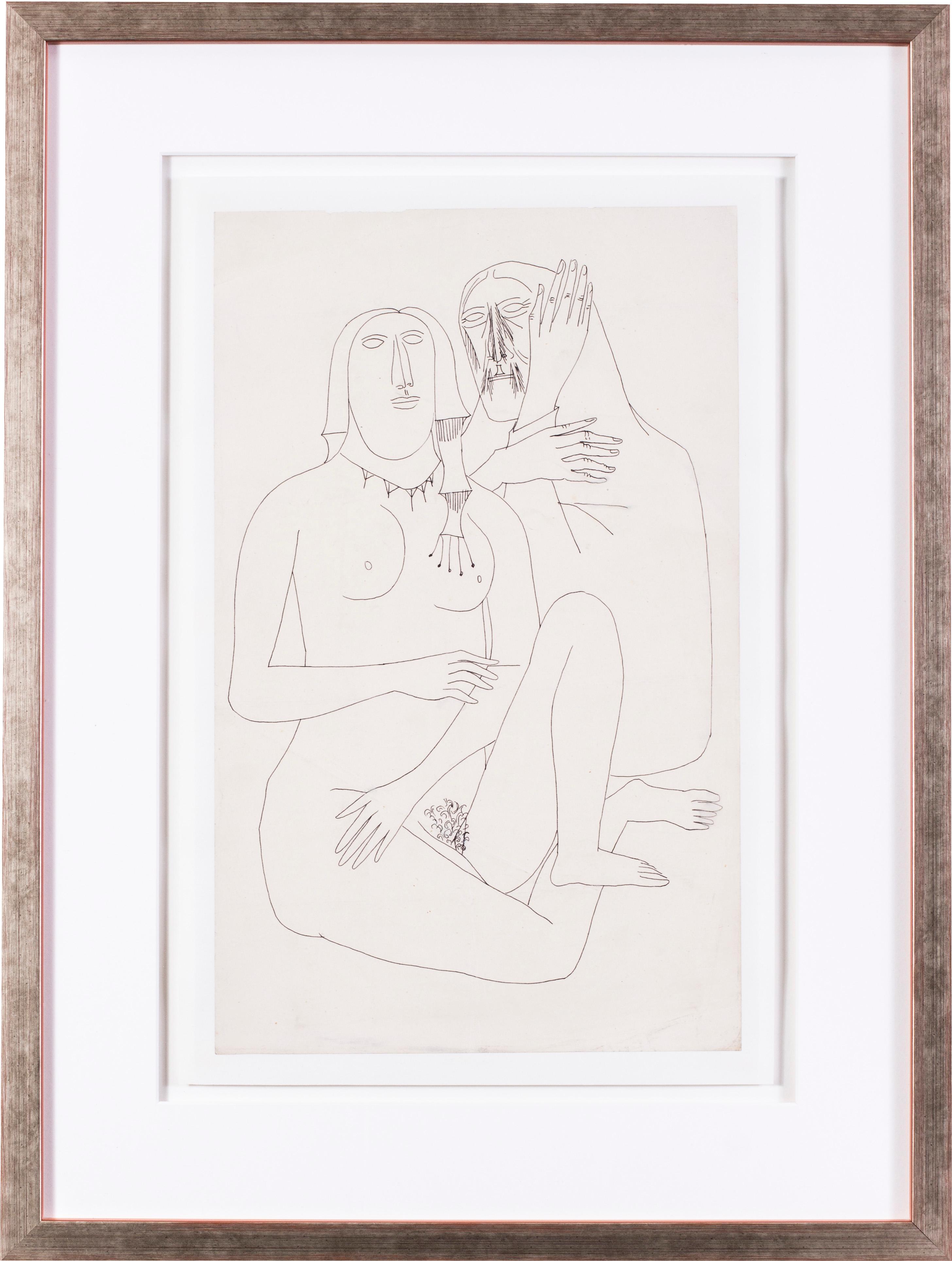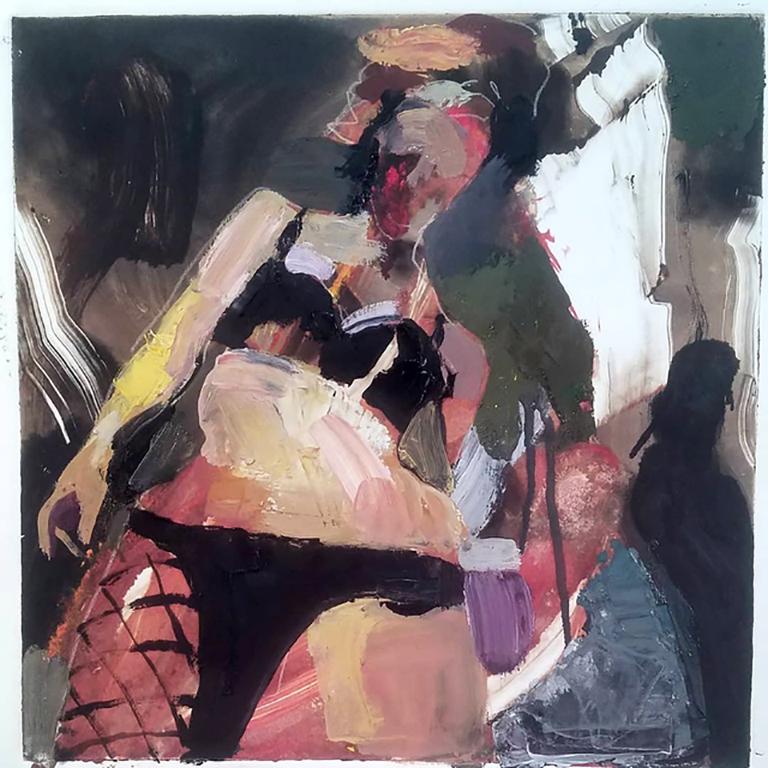Items Similar to Abstract Expressionist CoBrA Style Figure. Chalk on Card.
Want more images or videos?
Request additional images or videos from the seller
Abstract Expressionist CoBrA Style Figure. Chalk on Card.1970s
1970s
About the Item
Abstract expressionist CoBrA style chalk on paper of a human figure attributed to French artist, A Nuchy. The work is unsigned but was acquired along with other works signed by the artist and also available on 1st Dibs.
Highly colourful and inventive this chalk on paper exemplifies the total freedom of expression embraced by the CoBrA style.
Simple, bold , naiive, experimental and almost childlike in its execution. These are the qualities which bring exciting colour, form and a sense of freedom and joy to CoBrA paintings and this fine example.
COBRA (or CoBrA) was a European avant-garde movement active from 1948 to 1951. The name was coined in 1948 by Christian Dotremont from the initials of the members' home countries' capital cities: Copenhagen (Co), Brussels (Br), Amsterdam (A).
During the time of occupation of World War II, the Netherlands had been disconnected from the art world beyond its borders. COBRA was formed shortly thereafter. This international movement of artists who worked experimentally evolved from the criticisms of Western society and a common desire to break away from existing art movements, including "detested" naturalism and "sterile" abstraction. Experimentation was the symbol of an unfettered freedom, which, according to Constant, was ultimately embodied by children and the expressions of children. COBRA was formed by Karel Appel, Constant, Corneille, Christian Dotremont, Asger Jorn, and Joseph Noiret on 8 November 1948 in the Café Notre-Dame, Paris, with the signing of a manifesto, "La cause était entendue" ("The Case Was Settled"), drawn up by Dotremont. Formed with a unifying doctrine of complete freedom of colour and form, as well as antipathy towards Surrealism, the artists also shared an interest in Marxism as well as modernism.
Their working method was based on spontaneity and experiment, and they drew their inspiration in particular from children’s drawings, from primitive art forms and from the work of Paul Klee and Joan Miró. Interestingly a large influence on this movement's style was the discovery and opening of the Lascaux caves in the Dordogne region of France 10 years before the group formed.. The freely expressive primitive cave paintings were inspirational, offering a childlike naiivety and total freedom of expression which the CoBrA members fully embraced. The CoBrA movement although short lived ( only 1948-51 ) went on to have enormous impact in the artworld over the decades and into the present day.
- Attributed to:A Nuchy
- Creation Year:1970s
- Dimensions:Height: 29.41 in (74.7 cm)Width: 20.36 in (51.7 cm)Depth: 0.08 in (2 mm)
- Medium:
- Movement & Style:
- Period:
- Condition:The image itself is in good condition however there has been some water damage (now dry) to the bottom left corner which is not immediately noticeable and would not be visible once framed.
- Gallery Location:Cotignac, FR
- Reference Number:
About the Seller
5.0
Platinum Seller
These expertly vetted sellers are 1stDibs' most experienced sellers and are rated highest by our customers.
Established in 2000
1stDibs seller since 2020
165 sales on 1stDibs
Typical response time: 1 hour
- ShippingRetrieving quote...Ships From: Cotignac, France
- Return PolicyA return for this item may be initiated within 3 days of delivery.
More From This SellerView All
- Mother Nature, Lyrical Surrealist Abstract Watercolour on Paper.Located in Cotignac, FRMid-century lyrical surrealist abstract watercolour on paper by French artist Jean Clerté, signed and dated bottom right. Presented in mid-century frame. Jean Clerté , born in 1930 in Saint-Savin-sur-Gartempe in Vienne, is a French painter, engraver, draftsman, watercolourist and sculptor . This work is a great example of his more humorous and expressive work influenced by Alechinsky from the late 1960s onwards. There is a light playfulness and yet the watercolours are more vivid than his previous palette. Jean Clerté works in series. His sequential narrations testify both to a youthful spontaneity and to a perfect mastery in the distribution of forms and images on the painted surface. The narration is not only an accumulation of juxtaposed fragments and symbols, it forms a whole, it takes on and gives meaning. In general, we can say of Clerté that he practices an “eco-art” that feeds on primary hungers: the feeling of being united with nature, the vegetable, the mineral, the aquatic. In his colourful canvases, his inks, his boxes, his objects, like a shaman on the path of his dreams, the painter Clerté mounts an assault on beasts and demons, elves and gnomes. From the Poitevin marshes to the tropical forests emerges a fauna caught in the meanders of a design that marvels at the appearance of these grotesque idols. Jean Clerté began to draw and paint at a very young age, and at the age of 15 he enrolled at the École des Beaux-Arts in Poitiers. Then in 1949, curious about the capital, he moved to Paris. Having very few financial resources, he could not continue his studies at first, worked as a model to survive, and met other artists; he was then admitted to the studio of Ossip Zadkine and, from 1952, he was also able to study engraving at Atelier 17 of Stanley William Hayter, an English engraver and printer living in Paris associated in the 1930s with surrealism. At the end of the 1960s, he worked alongside Pierre Alechinsky, founding member of the Cobra movement, engraving Alechinsky's originals, benefiting from his advice, and discovering acrylic as a medium. From 1976, Jean Clerté became associate professor at Hayter. Clerté had taught previously, in 1971 at the Salzburg Summer University and in 1972 he gave courses at the Paris-Sorbonne University . In 1981, he was appointed professor at the School of Decorative Arts , where he had Maïlys Seydoux-Dumas as a student and, from 1983 to 1988, he was Alechinsky's assistant professor at the Paris School of Fine Arts. His first works are part of the current of lyrical abstraction, and are nourished by impressions of nature (landscape motifs, e.g. forest fires, waterscapes), then around 1968, encouraged by Alechinsky, he rejects abstraction, and his work becomes more figurative with expressive and humorous elements. From this period his colours are more subdued, often with pastel tones, he works on series. Jean Clerté has created a world in a space where drawing, painting, objects participate in a playful figuration. From his drawings were born sculptures and sometimes mobiles (Le Moulin à dessin). If it is the artist who makes astonishing, polychrome, whimsical “toys”, it is the painter who appeals to adults through his caustic and satirical humour. His first exhibitions in France took place at the Galerie Massol , then at the Galerie Pascal...Category
Mid-20th Century Surrealist Figurative Drawings and Watercolors
MaterialsPaper, Watercolor
- Abstract Expressionist CoBrA Style Anthropomorphic Bird. Chalk on Paper.Located in Cotignac, FRAbstract expressionist CoBrA style chalk on paper of an imaginary bird by French artist, A Nuchy. Signed to the bottom right. Highly colourful and inventi...Category
1970s Abstract Expressionist Animal Drawings and Watercolors
MaterialsPaper, Chalk
- Napoleon at the Head of His Grande Armée, His Generals and the Prussian HussarsLocated in Cotignac, FRPencil, chalk and watercolour depiction of Napoleon at the head of his generals by French artist Jean Ducel. The work is signed bottom right. A bold and graphic depiction of Napoleo...Category
Late 20th Century Romantic Figurative Drawings and Watercolors
MaterialsWatercolor, Chalk, Crayon, Cardboard, Pencil
- Abstract Expressionist Biomorphic Coloured Pencil Drawing.Located in Cotignac, FR1980s abstract expressionist biomorphic coloured pencil drawing on paper by Belgian artist André Pierret, signed bottom right. André Pierret was born ...Category
1980s Abstract Expressionist Abstract Drawings and Watercolors
MaterialsPaper, Carbon Pencil, Color Pencil
- Persephone, 19th Century Classical French Academy DrawingLocated in Cotignac, FR19th Century French Academy drawing of a classical maiden, signed Xavier Rendeley bottom right, numbered and dated 2nd April 1883. Presented in ...Category
1880s Academic Figurative Drawings and Watercolors
MaterialsPaper, Chalk, Pencil
- 18th Century Sanguine Drawing, La Naissance de Louis XIII, After Rubens.Located in Cotignac, FR18th Century French Sanguine drawing, possibly a preparatory sketch for the painting by Nattier after the painting by Rubens. Presented in shaped 'marie-louise' mount in plain gold wood frame with collection label. The subject is the Queen Marie de' Medici seated on a grand throne, the baby is in the arms of Health while Justice looks over him. Fecundity brings a cornucopia of fruit with the heads of the other children the Queen will bear. The Sun rides his chariot across the sky to indicate that Louis XIII was born in the morning and the calm figure of France surveys the whole scene. An engraving exists (see the Wellcome Collection) of this same image: 'The birth of King Louis XIII', after the engraving by B. Audran the younger after the painting by Jean-Marc Nattier after the oil painting of Peter Paul Rubens in the Louvre 'La Naissance du Dauphin (future Louis XIII) à Fontainebleau, le 27 septembre 1601'. Jean-Marc Nattier (17 March 1685 – 7 November 1766) was a French painter. He was born in Paris, the second son of Marc Nattier (1642–1705), a portrait painter, and of Marie Courtois (1655–1703), a miniaturist. He is noted for his portraits of the ladies of King Louis XV's court in classical mythological attire. He received his first instruction from his father, and from his uncle, the history painter Jean Jouvenet (1644–1717). He enrolled in the Royal Academy in 1703 and applied himself to copying pictures in the Luxembourg Palace, making a series of drawings of the Marie de Médici painting...Category
18th Century Baroque Figurative Drawings and Watercolors
MaterialsInk, Chalk, Paper, Clay
You May Also Like
- Doble Standard 14. From The Doble Standard Series. Watercolor PaintingLocated in Miami Beach, FLDoble Standard 14, 2023 by James Bonachea From The Series Doble Standard Series Watercolor on cardboard Image size: 58 cm H x 40 cm W Unframed The mor...Category
2010s Abstract Abstract Drawings and Watercolors
MaterialsWatercolor, Cardboard
- Doble Standard 10. From The Doble Standard Series. Watercolor PaintingLocated in Miami Beach, FLDoble Standard 10, 2023 by James Bonachea From The Series Doble Standard Series Watercolor on cardboard Image size: 58 cm H x 40 cm W Unframed The mor...Category
2010s Abstract Abstract Drawings and Watercolors
MaterialsWatercolor, Cardboard
- Abstract Expressionist Gestural Oil Pastel Drawing Women Figures Anthony TrianoLocated in Surfside, FLAnthony Thomas Triano (1928–1997) was an abstract expressionist painter, sculptor, illustrator and teacher. His works feature natural forms, especially the human form, and tend towar...Category
1960s Abstract Expressionist Abstract Drawings and Watercolors
MaterialsPaper, Oil Pastel
- Souza, Indian 20th Century artist, drawing of two nudesBy Francis Newton SouzaLocated in Petworth, West SussexFrancis Newton Souza (Indian, 1924 – 2002) Lovers Pen on paper 15.3/4 x 9.7/8 in. (40 x 25 cm.) Provenance: The artist’s wife Maria, Nee Figueiredo, gifted to her nephew There are ...Category
Mid-20th Century Abstract Expressionist Abstract Drawings and Watercolors
MaterialsPaper, Pen
- Good Friday, abstract female figureBy Tom BennettLocated in Brooklyn, NYOil on paper, signature Tom Bennett freedom of rich brushwork, warm colorsCategory
2010s Abstract Expressionist Figurative Drawings and Watercolors
MaterialsPaper, Oil
- double-sided marker drawing spanish abstract expressionismBy Ignacio Gil SalaLocated in Barcelona, BarcelonaOne side signed. Lower right corner slightly bent. Measures 29x20. Frameless. Ignacio Gil Sala, was a painter, bohemian character, adventurous and intrepid traveler who knew how to ...Category
1980s Abstract Expressionist Figurative Drawings and Watercolors
MaterialsPermanent Marker




